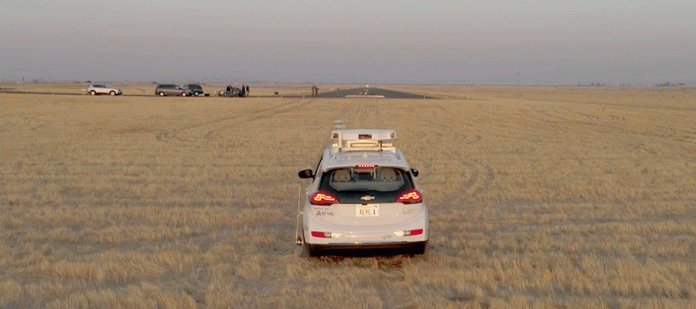AEye, a world leader in artificial perception systems and the developer of iDAR™, today announced a major breakthrough in long-range threat detection and safety. In performance specification tests monitored and validated by VSI Labs, one of the nation’s leading automated vehicle technology advisors, AEye’s iDAR system detected and tracked a truck at 1,000 meters, or one kilometer – four to five times the distance current LiDAR systems are able to detect. AEye’s test sets a new benchmark for solid-state LiDAR range, and comes one month after AEye announced a 100Hz scan rate – setting a new speed record for the industry.
AEye’s iDAR system detected and tracked a truck at 1,000 meters, or one kilometer – four to five times the distance current LiDAR systems are able to detect. AEye’s test sets a new benchmark for LiDAR range, and comes one month after AEye announced a 100Hz scan rate – setting a new speed record for the industry.
The company simultaneously announced $40M in Series B funding, led by Taiwania Capital. The round was significantly oversubscribed and includes multiple global automotive OEMs, Tier 1s, and Tier 2s to be formally announced at CES in January. In addition to Taiwania Capital, existing investors Kleiner Perkins, Intel Capital, Airbus Ventures and Tychee Partners also participated.
New Range and Scan Rate Records Key to Autonomous Automotive and Trucking Safety
Using AEye’s standard iDAR sensor, the company set up a formal test, monitored by VSI Labs, the leading research and development resource for active safety and automated vehicle technologies. The test was structured to establish and verify the range and scan rates of the iDAR system.
The test was conducted on the runway of an airport in Byron, California in order to isolate targets to better measure and calibrate iDAR’s performance. To test range, a standard 20-foot moving truck was tracked and continuously scanned down the length of the 914-meter runway. At the end of the runway, the iDAR system was fully able to continuously detect, and track the movements of the vehicle as well as detect runway signs and markers en route. The AEye sensor vehicle was then taken off the runway to extend the available test range to over 1000m, where iDAR continued to track the truck without difficulty.
“The test conducted by AEye delivered impressive results,” said Sara Sargent, senior engineer at VSI Labs. “We monitored the performance and the truck was clearly identifiable and visible at 1 kilometer. We were also able to verify that AEye’s iDAR system achieves scan rates of 100Hz and that the fusion of the camera and LiDAR in the iDAR sensor produces accurate true color real-time point clouds in the form of Dynamic Vixels. This is an outstanding achievement that demonstrates the true potential of perception systems to reliably and accurately detect and track objects at great range.”
iDAR and Biomimicry
AEye’s iDAR is an intelligent artificial perception system that physically fuses an agile, solid-state LiDAR with a hi-res camera to create a new data type called Dynamic Vixels. These Dynamic Vixels are the result of real-time integration of iDAR’s Agile LiDAR and a low-light camera in the IDAR sensor, not post fusion of a separate camera and LiDAR system after the scan. By capturing x, y, z, r, g, b data, Dynamic Vixels are uniquely created to biomimic the data structure of the human visual cortex. Better data drives vastly superior performance and delivers more accurate information. AEye’s use of Biomimicry is more fully explored by Dr. James Doty, world renowned neurosurgeon and clinical professor in the Department of Neurosurgery at Stanford University, in an article he recently published.
“After establishing a new standard for LiDAR scan speed, we set out to see just how far we could accurately search, acquire and track an object such as a truck,” said Blair LaCorte, Chief of Staff at AEye. “The iDAR system performed as we expected. We detected the truck with plenty of signal to identify it as an object of interest, and then easily tracked it as it moved over 1000m away. We now believe that with small adaptations, we can achieve range performance of 5km to 10km or more. These results have significant implications for the autonomous trucking and Unmanned Aircraft Systems (UAS) markets, where sensing distance needs to be as far as possible and potential threats identified as early as possible to achieve safe, reliable vehicle autonomy.”
New Funds Fuel Company’s Global Expansion
In addition, AEye announced the close of its Series B round, bringing the company’s total funding to over $61 million. The funds will be used to scale AEye’s operations to meet global demand for the company’s artificial perception systems for autonomous vehicles. AEye is uniquely structured to effectively scale through partnerships with contract manufacturers and Tier 1s on a global basis. This has allowed the company to focus on its core design and innovation competencies, avoiding the costs of building manufacturing capacity, while optimizing investment dollars on higher value activities. AEye’s growth has been fueled by its ability, as a software driven platform, to provide artificial perception systems that address both ADAS and Mobility solutions and engagements with customers and partners in Europe, North America, and Asia.
“This funding marks an inflection point for AEye, as we scale our staff, partnerships and investments to align with our customers’ roadmap to commercialization,” said Luis Dussan, AEye founder and CEO. “Our strategic relationship with Taiwania will serve as a gateway to Asia, with valuable manufacturing, logistics and technology resources that will accelerate our ability to address the needs of a global market. We intend to launch our next generation product at CES, which we believe will help OEMs and Tier 1s accelerate their products and services by delivering market leading performance at the lowest cost.”
“We see AEye as the foremost innovator in this space, whose systems deliver highly precise, actionable information at speeds and distances never seen in commercially available LiDAR sensors,” said Huang Lee, Managing Partner at Taiwania. “We look forward to working closely with AEye’s team to explore and pursue growth opportunities in this burgeoning space.”
AEye takes a disruptive approach to vehicle perception by putting intelligence at the sensor layer and making it extensible and controllable via a software driven architecture. The company’s iDAR system is an intelligent artificial perception system that physically fuses an agile, solid-state LiDAR with a hi-res camera to create a new data type called Dynamic Vixels with integrated software definable feedback control loops. This enables the iDAR sensor to also dynamically assess and prioritize what’s most relevant in a scene, then process this data at the edge. This is way above and beyond the function of legacy fixed pattern LiDAR systems and standalone cameras with 2D computer vision algorithms. This unique approach enables rapid, dynamic perception & path planning, for drastically improved autonomous vehicle safety and performance.
About AEye
AEye is an artificial perception pioneer and creator of iDAR™, a perception system that acts as the eyes and visual cortex of autonomous vehicles. Since its demonstration of its solid-state LiDAR scanner in 2013, AEye has pioneered breakthroughs in intelligent sensing. The company is based in the San Francisco Bay Area, and backed by world-renowned investors including Kleiner Perkins Caufield & Byers, Taiwania Capital, Intel Capital, & Airbus Ventures.
.About Taiwania Capital
Taiwania Capital is a venture capital firm sponsored by the Taiwan government and large private enterprises. Founded in 2017, Taiwania Capital is focused on ICT-related sectors and startups in fields including: enterprise IT infrastructure and software, AI, IoT, network security, industrial automation, drones and robotics, next-gen semiconductors, autonomous vehicle technology, and digital devices. With offices in both Taiwan and Silicon Valley, Taiwania Capital exclusively backs startups that will turn the promises of technological advancement into scalable applications.




